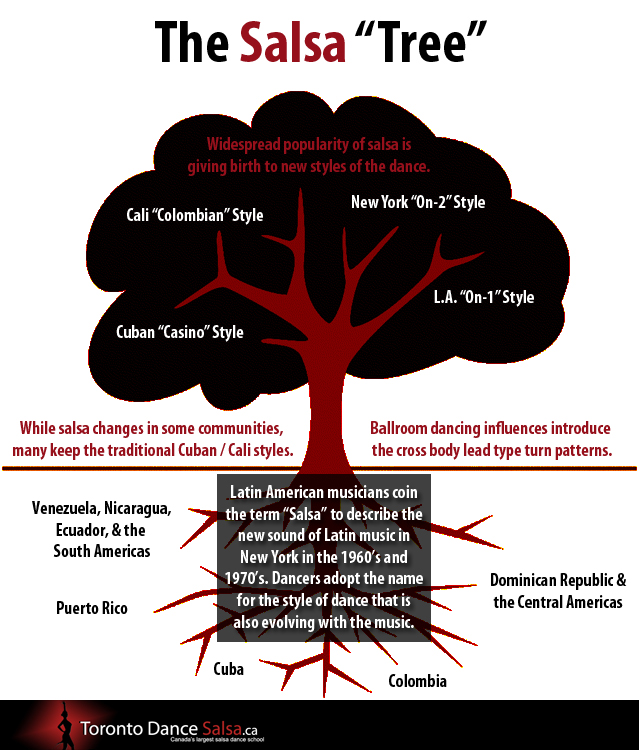Some Ideas on Dance San Francisco You Need To Know
Table of ContentsAn Unbiased View of Dance San FranciscoThe 30-Second Trick For Dance San FranciscoFascination About Dance San FranciscoAbout Dance San FranciscoDance San Francisco - TruthsThe 9-Minute Rule for Dance San FranciscoDance San Francisco Things To Know Before You Buy
The significant difference that distinguishes the Miami-style from other North American styles is the "Atras" or "Diagonal", back damaging actions executed backwards diagonally rather than moving forwards and in reverse as seen in the New York style. Professional dancers do not shift their body weight substantially as seen in other styles. bay area salsa dancing. Instead, professional dancers maintain their upper body still, poised and kicked back, concentrating on foot activityA major distinction in between Cali Design and Miami-style is the last is exclusively danced on the downbeat (On1) and has aspects of sparkles and show-style included to it, adhering to collections of North American designs. Miami-style has several followers, particularly Cuban-Americans and various other Latinos based in South Florida.
Most of the relocations involve rapidly exchanging partners. "Rueda de Cuba" is initial sort of Rueda, originating from Cuba. It is not as formal as Rueda de Miami and contains about 30 telephone calls. [] It was codified in the 1970s. [] "Rueda de Miami" come from the 1980s from Miami, is an official style with many rules based on a mix, and is a hybridization of Rueda de Cuba & North American dance designs, with some regimens mirroring American culture (e.
Dance San Francisco for Beginners
Coca-Cola, Dedo, Adios) which is not found in the traditional Cuban-style Rueda - bay area salsa dancing. Cali-Style Salsa, also referred to as Colombian Salsa and Salsa Calea, is based around the Colombian City of Cali. Cali is also understood as the "Resources de la Salsa" (Salsa's Capital); as a result of salsa music being the major style in parties, bars and celebrations in the 21st century.
The aspects of Cali-Style Salsa were highly affected by dancings to Caribbean rhythms which preceded salsa, such as Pachanga and Boogaloo. Cali has the greatest variety of salsa institutions and salsa groups worldwide. A number of the competitors are held in Colombia. The main feature is the maneuvering which has quick rapid steps and avoiding movements called "repique".
Dance San Francisco Things To Know Before You Buy
They consist of various acrobats such as partnered turns to captivate with these jaw going down stunts. Their footwork is detailed and exact, helping a number of Colombian Design professional dancers win major globe championships. Cali hosts several yearly salsa events such as the Globe Salsa Cali Festival and the Encuentro de Melomanos y Coleccionistas.
Researchers in the natural sciences researched the mathematics of salsa dancing steps. In the social sciences, researchers have studied salsa dance to comprehend, for instance exactly how the Latino identity is linked to salsa dance.
and, scientists have actually additionally used salsa dancing to research the ephemerality of social teams. Salsa music the music to which salsa is danced Mambo a dancing style which greatly affected salsa dancing Palladium Ballroom a New York City venue that helped popularize Latin songs and dancing throughout the 1940s and 1950s Rhumba a ballroom dance that heavily influenced salsa Globe Salsa Championships a listing of worldwide competitions for salsa dance Cuban salsa a prominent kind of salsa dancing from Cuba Boggs, Vernon (1992 ).
Fascination About Dance San Francisco
ISBN 0-313-28468-7. OCLC 24908952. Hutchinson, Sydney (2004 ). " Mambo on 2: The birth of a brand-new type of dancing in New york city City" (PDF). Centro Journal. 16: 108137. ISSN 1538-6279. " What Is Salsa (Dance)?". 2023-03-13. Gotten 2023-05-26. Youthful, Takeshi (26 June 2023). " Latin Dancing". Salsa Vida. Retrieved 5 October 2023. " Creating salsa".
Retrieved 5 October 2023. " Background of Salsa Dancing". Salsa Vida. 26 June 2023. Recovered 5 October 2023. Ludovic, Kiss Mihai (2015-10-01). " Salsa Origins and Development". Sport i Societate. 15 (Special): 120129. ISSN 1582-2168. Djebbari, Elina (2020-01-02). " Dancing salsa in Benin: Connecting the Creole Atlantic". Atlantic Researches. 17 (1 ): 110134. doi:10.
2019.1697579. ISSN1478-8810. Carwile, Christey (September 2017). "" The Clave Returns": Salsa Dancing and Pan-African Identification in Ghana". African Researches Evaluation. 60 (2 ): 183207 - https://evans-wondrous-site-756696.webflow.io/. doi:10. 1017/asr. 2017.6. ISSN0002-0206. " Salsa vs Bachata: What's the Distinction?". Salsa Vida. 2021-08-08. Fetched 2021-09-08. " Dancing Styles". Salseros Mc, Gill. Recovered 2023-03-14 (bay area salsa dancing). " Salsa & Latin Dance Congresses"
Dance San Francisco - Questions

The city of music memory: salsa, record grooves, and preferred society in Cali, Colombia. Salsa Vida SF. The Journal of Popular Culture.
The Of Dance San Francisco
9 (2 ): 113125. doi:10. 1002/cb. 308. Holmqvist, Jonas; Diaz Ruiz, Carlos; Pealoza, Lisa (2020-08-01). " Moments of luxury: Hedonic escapism as a deluxe experience". Journal of Business Research Study. 116: 503513. doi:. ISSN 0148-2963. S2CID 211427257. Diaz Ruiz, Carlos A.; Penaloza, Lisa; Holmqvist, Jonas (2020-01-01). " Putting together tribes: An assemblage believing technique to the characteristics of ephemerality within consumer tribes".

Something went wrong. Wait a moment and try once more Attempt again.
Everything about Dance San Francisco
We're speaking about the dance, not the tasty South American dressing. The beginnings of words "Salsa" as the name of a dance has actually been a resource of argument for decades. The most prominent (and possibly approved) concept is that Cuban and Puerto Rican artists in New york city created the expression in New York in the 1970's, to define the spicy blend of songs they were developing out of the rhythms and themes of Cuban son montuno, guaracha, chachacha, mambo and bolero.